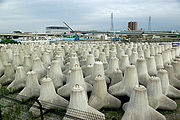.gif)
Tetrapod (structure)
Encyclopedia


Concrete
Concrete is a composite construction material, composed of cement and other cementitious materials such as fly ash and slag cement, aggregate , water and chemical admixtures.The word concrete comes from the Latin word...
structure used as armour unit on breakwater
Breakwater (structure)
Breakwaters are structures constructed on coasts as part of coastal defence or to protect an anchorage from the effects of weather and longshore drift.-Purposes of breakwaters:...
s. The Tetrapod's shape is designed to dissipate the force of incoming waves by allowing water to flow around rather than against it, and to reduce displacement by allowing a random distribution of Tetrapods to mutually interlock.
Earlier barrier material used in breakwater
Breakwater (structure)
Breakwaters are structures constructed on coasts as part of coastal defence or to protect an anchorage from the effects of weather and longshore drift.-Purposes of breakwaters:...
s, such as boulders and conventional concrete blocks, tended to become dislodged over time by the force of the ocean constantly crashing against them. Tetrapods and similar structures are often numbered so any displacement that occurs can be monitored through satellite photos.
The unit was originally developed in 1950 by Laboratoire Dauphinois d'Hydraulique in Grenoble
Grenoble
Grenoble is a city in southeastern France, at the foot of the French Alps where the river Drac joins the Isère. Located in the Rhône-Alpes region, Grenoble is the capital of the department of Isère...
, France
France
The French Republic , The French Republic , The French Republic , (commonly known as France , is a unitary semi-presidential republic in Western Europe with several overseas territories and islands located on other continents and in the Indian, Pacific, and Atlantic oceans. Metropolitan France...
(now Sogreah ). They are no longer protected by a patent, and are widely used all over the world, produced by many contractors.
The Tetrapod inspired many similar concrete structures for use in breakwaters, including the Modified Cube (U.S., 1959), the Stabit (U.K., 1961), the Akmon
Akmon
An akmon is a multi-tonne concrete block used for breakwater and seawall armouring. It was originally designed in the Netherlands in the 1960s, as an improvement on the tetrapod.-References:...
(Netherlands, 1962), the Dolos
Dolos
A dolos is a concrete block in a complex geometric shape weighing up to 20 tons, used in great numbers to protect harbour walls from the erosive force of ocean waves...
(South Africa, 1963), the Seabee (Australia, 1978), the Accropode (France, 1981), the Hollow Cube (Germany, 1991), the A-jack
A-jack
A-Jacks are a commercially made concrete product used in both open channel and coastal applications. They consist of two concrete T-shaped pieces joined perpendicularly at the middle, forming six legs...
(U.S., 1998), and the Xbloc
Xbloc
An Xbloc is an interlocking concrete block or armour unit designed to protect shores, harbour walls, seawalls, breakwaters and other coastal structures from the direct impact of incoming waves...
(Netherlands, 2001), among others. In Japan, the word Tetrapod is often used as a generic name for wave-dissipating blocks including other types and shapes.
Criticism
Tetrapods have been shown to offer little advantage compared to other concrete armour units. Layering and the amount of tetrapods have shown to have no appreciable effect on the stability of the tetrapod structures although stability increases with the size of the tetrapod pad.Tetrapods have also been criticized for causing more damage than they prevent because they alter ocean currents and disrupt the natural cycles of erosion and deposition that form and reshape coasts. Concrete coastal installations can also be lethally dangerous to swimmers and surfers, as well to shipping and recreational boaters.
New shore protection innovations have shown that there are better methods that are less obtrusive and more environmentally friendly than concrete armor structures. Alternate placements of sand and mix sediments and modifications of incident wave conditions through the use of reefs are examples of those.

